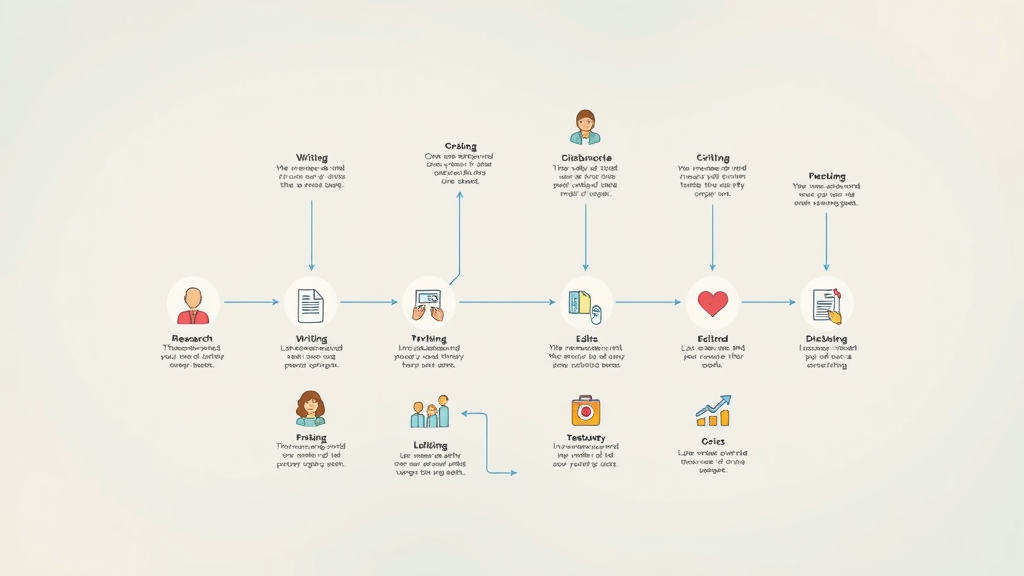Did you know that businesses with a streamlined content creation process generate four times as much content with the same resources as their competitors? In today’s fast-paced digital world, mastering your content workflow isn’t just an advantage—it’s a necessity. This guide will show you how to unlock brand growth, save countless hours, and consistently deliver great content that stands out. Whether you’re a marketer, entrepreneur, or creator, you’ll find practical strategies here that transform how you approach every piece of content.
What You’ll Learn: Proven methods to streamline your workflow, practical examples from top brands, best practices for teams, and step-by-step guidance covering everything from keyword research to performance analytics.

Unlocking Efficiency: Why Mastering the Content Creation Process Transforms Brands
- A recent study found that businesses with a streamlined content creation process produce 4x more content with the same resources. Discover how refining your content creation process can elevate your brand, save countless hours, and build lasting engagement.
The content creation process is more than just a set of instructions—it’s a growth engine for your brand. Companies that formalize and streamline their creation process consistently achieve better engagement, improved search engine visibility, and stronger brand loyalty. By adopting an efficient process, you enable teams to collaborate, create content faster, and reduce costly inefficiencies.
Imagine building a reputation as a thought leader because your brand regularly publishes high-quality, relevant content. That’s the power of a great workflow: it transforms scattered ideas into actionable plans and ensures every piece of content you create aligns with your marketing objectives. As you refine your content creation efforts, you’ll not only save time but see compounding returns in audience growth and revenue.
Content Creation Process Fundamentals: Building the Foundation for Great Content
- Defining the content creation process and its importance
- How content creation drives marketing ROI
- Connecting content creation to broader content marketing strategies
The content creation process refers to the organized, step-by-step approach for developing great content —from brainstorming and outlining all the way through editing and publication. This process is crucial because it ensures every piece of content is aligned with brand goals, resonates with your target audience , and supports larger content marketing efforts. Rather than creating content haphazardly, a well-structured process delivers consistency, saves time, and elevates overall quality.
As marketers increasingly compete for attention, understanding the basics of content creation can make or break ROI. Consistent processes result in more reliable deadlines, less wasted effort, and content that performs well with both readers and search engines . Moreover, integrating the content creation process into your content strategy ensures seamless collaboration among teams, from content creators to editors and designers.

Types of Content: Understanding What Fits Your Strategy
- Overview of content types: blog posts, white papers, social media, digital content, website content
- Choosing the right content for your audience and niche
- Effective content creation for multiple channels
Choosing the type of content that aligns with your business goals and audience is a key part of a successful content creation process . Blog posts are excellent for sharing insights, building SEO authority, and answering your audience’s pressing questions. White papers establish thought leadership, especially in B2B markets, by presenting in-depth research and solutions to challenging problems. Social media content amplifies your reach, engaging audiences where they naturally spend time.
The right mix often includes digital content , such as videos, podcasts, and interactive infographics, tailored to different channels and platforms. For example, quick tips and updates work well for social platforms, while longer-form website content can attract organic traffic over time. The choice ultimately depends on your target audience and where they are most active—an essential consideration for every content creator .
- Blog posts
- White papers
- Social media posts
- Videos
- Podcasts
- Infographics

Step-by-Step Content Creation Process: From Keyword Research to Publication
- Conducting keyword research for great content
- Generating content ideas with audience pain points in mind
- Creating content outlines and drafts
- Editorial calendar planning and scheduling
- Content editing and optimization before publishing
A practical content creation process always starts with understanding your target audience and their pain points. The next step is keyword research , followed by idea generation that considers what problems your audience faces and what questions they need answered. Outlines—especially for blog posts , white papers , and digital content —help shape your message and format.
Utilize an editorial calendar to schedule content production and ensure consistency. The editing and optimization stage involves refining content for readability, SEO, and brand voice. Whether you’re writing a blog post, developing social media content, or preparing a thought leader article, following a robust process ensures every piece of content you create fulfills its strategic purpose.
Keyword Research: The Secret to Creating Content That Ranks

- Keyword research tools and techniques
- Aligning content ideas with search intent
- Utilizing NLP and competitor research for topic selection
Keyword research is foundational to the content creation process . Successful blog posts and website content rely on identifying the terms your audience uses to find solutions. Leverage tools like Google Keyword Planner, Ahrefs, or SEMrush to discover high-potential keywords and phrases that fit your content strategy . It’s essential to analyze the search intent behind each keyword—what is your audience looking to learn, buy, or solve when they search for these terms?
In addition to traditional tools, consider natural language processing (NLP) insights to uncover related topics and expand your pool of content ideas . Analyze what competitors are publishing by evaluating their blog posts and seeing what types of content perform best. This way, you’ll not only drive more traffic but also create effective content that genuinely meets audience needs.
Generating Content Ideas and Crafting Editorial Calendars
- Idea generation for blog posts and digital content
- Editorial calendar tools and best practices
“The way to create great content is to think like your reader and solve their problems before they know they have them.”
Uncovering content ideas starts with listening to your audience—review frequently asked questions, social comments, and trending topics in your industry. Use brainstorming sessions to generate a variety of potential topics, ensuring each aligns with your overall content strategy . Modern idea generation often involves tools like MindMeister, Trello, and BuzzSumo to spark creativity and map out winning topics across multiple types of content .
Once ideas are set, an editorial calendar is crucial for organizing your workflow, balancing seasonal topics, and planning ahead for launches or campaigns. Leading content creators rely on calendars (like CoSchedule or Asana) to create, schedule, and track every piece of content —from blog posts to website content and beyond. This structure prevents last-minute scrambles and supports consistent, high-quality publication.

Content Creation for Social Media: Strategies, Tools, and Trends
- Adapting the content creation process for social media platforms
- Social media scheduling and analytics
- Great content examples from leading brands
The content creation process for social media requires quick turnaround and adaptability to trends. Success comes from repurposing blog posts , infographics, and other types of content into bite-sized updates tailored for each platform—LinkedIn, Instagram, Twitter, and beyond. High-performing brands track audience sentiment, analyze what resonates, and iterate their content strategy in real-time.
Scheduling tools like Buffer, Hootsuite, or Sprout Social are invaluable for planning, automating, and analyzing posts. Great content examples include behind-the-scenes videos, shareable infographics, and interactive polls that encourage engagement. Always monitor analytics to tweak your approach and ensure every piece of content contributes to your marketing goals.

Content Creation Tools: Streamlining Your Workflow
- Top tools for creating content, managing schedules, and optimizing workflow
- Comparing project management and content creation software
Today’s top content creators depend on technology to maximize efficiency. From Canva and Adobe Creative Cloud for visuals, to Grammarly for editing, and Google Docs for real-time collaboration, these tools remove bottlenecks from the creation process . Project management platforms like Trello, Asana, and Monday.com help streamline editorial calendars, delegate tasks, and keep complex projects on track.
For optimization, consider content research and SEO tools like Surfer SEO or Clearscope, which provide actionable insights to improve the quality and performance of digital content and website content . The right software enables your team to produce a higher volume of effective content without sacrificing standards or overloading staff.
| Tool | Features | Best For | Cost (Monthly) |
|---|---|---|---|
| Canva | Templates, Graphics, Video Editing | Social media, Blog posts, Infographics | Free / Pro $12.99 |
| Grammarly | Grammar checks, Style Suggestions | Editing all types of content | Free / Premium $12 |
| Asana | Task Management, Editorial Calendars | Content teams, Agencies | Free / Premium $10.99 |
| Buffer | Social Media Scheduling, Analytics | Social media managers | Free / Essentials $6 |
| Surfer SEO | SEO optimization, Content editor | Blog posts, Website content | From $49 |
Collaborative Content Creation: Working With Content Creators and Teams
- Building content creation teams and working with freelance content creators
- Workflow tips for larger organizations and agencies
- Content creator role definitions and responsibilities
Building effective content creation teams involves clearly defined roles and a transparent workflow. Whether you’re managing in-house staff or partnering with freelance content creators , set expectations for every contributor—writers, editors, designers, and strategists. Each role in the creation process must be understood so everyone aligns with the content strategy and brand voice.
Larger organizations and agencies often depend on detailed SOPs (standard operating procedures) and robust project management tools that encourage seamless communication. Schedule regular check-ins and use collaborative apps like Slack or Google Workspace to resolve bottlenecks. Remember: The best content creation process leverages each content creator’s strengths and promotes knowledge sharing for ongoing improvement.

Measuring Success: Content Creation KPIs and Analytics
- Tracking engagement, conversions, and ROI
- Adjusting your content creation process based on analytics
True mastery of the content creation process requires continuously measuring what works. Track engagement metrics—likes, shares, comments, time on page—as well as conversions, lead generation, and overall ROI. Tools like Google Analytics and HubSpot provide comprehensive dashboards to monitor how each piece of content contributes to your business objectives.
Review your analytics regularly to adjust your content strategy . Identify which types of content drive the most results, then focus energy there. A data-driven approach enables you to refine your content creation process, ensuring a steady flow of successful content and continuous ROI improvement with every blog post , infographic, or social update.

Overcoming Challenges in the Content Creation Process
- Common content creation process bottlenecks
- Staying creatively inspired and avoiding burnout
- Maintaining quality while scaling the content creation process
Every content creator faces obstacles—tight deadlines, creative blocks, or sudden priority shifts. Typical creation process bottlenecks include unclear workflows, approval delays, and task overload, which can stall even the best teams. Address these by simplifying feedback loops, setting realistic deadlines, and regularly reviewing workload distribution.
To keep creativity flowing and avoid burnout, encourage ideation sessions, build buffer time for brainstorming, and celebrate small wins. As your volume increases, document your content creation steps and invest in quality control—peer reviews, editorial checklists, and style guides all help maintain quality content . Remember, progress and reliability trump perfection, especially when scaling production.
“Consistency is the heart of an effective content creation process. Strive not for perfection, but for progress and reliability.”

Future Trends in Content Creation: AI, Automation, and Beyond
- How AI is transforming the content creation process
- Emerging trends for content creators
- The future of content marketing and audience engagement
AI and automation are quickly reshaping the content creation process . From AI-powered draft generators to automatic SEO optimizers, emerging tools can draft, edit, and analyze website content much faster than before. This shift allows content creators to focus on strategy, storytelling, and brand development, rather than repetitive tasks.
Looking forward, expect highly personalized content experiences, adaptive content strategies, and new interactive formats (such as AR/VR and immersive video). Staying agile and experimenting with new technology will keep your content competitive. AI may never fully replace human creativity, but it will amplify your ability to deliver great content at scale.

FAQs on the Content Creation Process
- What are the most important steps in the content creation process? The essential steps include understanding your target audience , conducting keyword research , generating content ideas , outlining, drafting, editing, optimizing, and finally publishing and promoting your piece of content .
- How do you choose what types of content to create? Consider where your target audience spends time and the kind of content they prefer. Research competitors’ blog posts , monitor trending digital content , and assess which formats work best for your niche.
- What skills should a content creator have? A solid content creator excels in research, writing, editing, SEO, creativity, project management, and analytics. Communication skills and adaptability are crucial for delivering quality across all types of content .
- Is the content creation process different for social media, blogs, or white papers? The fundamentals remain similar—research, outlining, drafting, and editing—but each format requires a tailored approach. Social media needs brevity and visuals, blog posts rely on storytelling and SEO, and white papers demand in-depth research and authoritative voice.
Related Questions: Answering 'People Also Ask'
What are the 7 steps of content creation?
- 1. Research and understand target audience
- 2. Conduct keyword research
- 3. Generate content ideas
- 4. Create content outlines
- 5. Produce initial drafts
- 6. Edit and optimize
- 7. Publish and promote
What is your content creation process?
- A personalized content creation process starts with research, brainstorming, planning, drafting, reviewing, optimizing, and distributing content tailored to strategic objectives.
What are the 4 pillars of content creation?
- 1. Strategy and research
- 2. Production/creation
- 3. Optimization
- 4. Distribution
What are the 5 C's of content creation?
- 1. Clarity
- 2. Consistency
- 3. Creativity
- 4. Community
- 5. Conversion
Best Practices and Expert Tips for the Content Creation Process
- Repurpose content to maximize output
- Leverage analytics for continuous improvement
- Foster team collaboration
- Balance creativity and consistency
- Maintain an editorial calendar for smooth workflow
“A robust content creation process is the backbone of great marketing. It’s not just about what you create, but how and why you create it.”
Summary: Key Takeaways for Optimizing Your Content Creation Process
- A well-structured content creation process streamlines your efforts
- Understanding types of content empowers strategic decisions
- Analytics and collaboration drive long-term content marketing success
- Stay flexible to incorporate new tools and industry trends

Ready to Transform Your Content Creation Process?
- Apply these strategies and best practices to master your own content creation process .
- Share this guide with your team and start producing great content efficiently today.
Take action now: Implement at least one new best practice from this article in your next project to witness immediate results in your content workflow efficiency!
 Add Row
Add Row  Add
Add 





Write A Comment